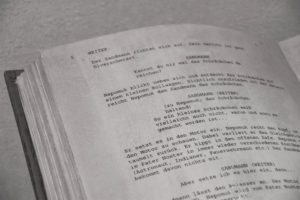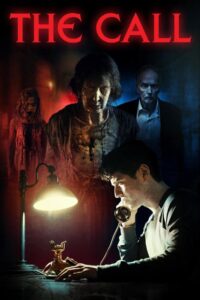A 5 act structure is a framework for organizing a story. Filmmakers often use a five-act structure to outline a script, and theater professionals may also use it to plan plays and other stage productions.
This framework’s origins lie in Aristotle’s early theory that a drama should have a beginning, a middle, and an end. Many early dramas followed a simple three-act structure with a prologue, climax, and denouement. Although it’s relatively simple, many contemporary filmmakers still use this framework. Movies like “Star Wars” and “Die Hard” use a three-act structure with a beginning, middle, and end.
In the 19th century, after analyzing various ancient Greek and Shakespearean works, German playwright Gustav Freytag introduced Freytag’s Pyramid, a standard five-act structure that many filmmakers use today.

Scene from “Shakespeare in Love“
Over the centuries, countless storytellers have used what would come to be known as Freytag’s Pyramid. William Shakespeare used the structure in many plays, and filmmakers like Steven Soderbergh used this framework in movies like “Erin Brokovich.”
How To Write Five-Act Structure
Both movies and TV shows can use a five-act structure to showcase characters overcoming challenges throughout the story. You can even use this structure for a novel, too. To develop a screenplay, first, think about the driving force or motivation for the main character. Then plot the conflict, which may be internal or external. Finally, consider how the main character should resolve the conflict and conclude the storyline effectively.
1. Set Up the Exposition in Act One
The first act of the film establishes the time and place and introduces the characters. It also sets the scene for a future conflict.
In many cases, the first act shows the main character living a regular, everyday life with which the audience can easily connect.
2. Begin the Rising Action in Act Two
In the second act of the film, the action begins to increase in intensity. The main character experiences a new situation as a result of starting the journey. In many films, the new situation takes place in a new location or environment.
The main character may experience a series of problems before the primary conflict.
3. Build to the Climax in Act Three
The third act serves as the turning point of the drama as the main character steadily works toward the primary goal.
This act often includes extensive suspense leading up to the climax.
This stage of the screenplay generally includes a series of conflicts and challenges for the protagonist to overcome.
It may also demonstrate the main character’s courage and tenacity.
4. Move Into Falling Action in Act Four
After the climax, the action begins to die down. Characters resolve outstanding concerns and no new conflicts appear.
5. End the Story With Resolution in Act Five
At the end of the film, the drama resolves. Finally, the main character can resolve any loose ends and work through the aftermath. This final stage may also show how the main character’s world has changed after reaching the end of the journey and how their world is now different.
Many filmmakers convey an overarching lesson or takeaway in the final act.
What Are the Five Turning Points for a Successful Screenplay?
Many Hollywood movies and TV shows also feature five essential turning points. You can use the outline below to enhance your screenplay for a feature-length film or TV pilot.
Turning Point 1: The Opportunity
The second 10% of the screenplay should present a major opportunity for the main character. This part of the storyline causes the main character to begin their journey and typically happens between acts one and two.
Turning Point 2: The Change of Plans
About a quarter of the way through the screenplay, the main character should experience a setback. This change in plans often cements the main character’s motivation to reach a goal. This turning point is often in act two.
Turning Point 3: The Point of No Return
Halfway through the screenplay, the main character should commit completely to the overarching goal. At this point, it should be clear that the main character can’t or won’t turn back. Turning point three occurs in act three.
Turning Point 4: The Major Setback
About three-quarters of the way through the screenplay, the main character should experience a serious obstacle. At this point, the audience should believe that the main character has little chance of succeeding. Turning point 4 is also in act three before the climax.
Turning Point 5: The Climax
About 90% of the way through the screenplay, the main character should encounter and overcome the biggest conflict. The climax often depicts the main character taking complete control over their fate. This turning point is at the end of act three before the falling action and resolution.
Other Types of Story Structures
Many feature films follow a nine-act structure, which is more complex than a standard five-act structure and can be ideal for helping writers create more character-driven stories. Most films that follow a nine-act structure also have a two-goal structure. Instead of having a single goal to pursue, the main character generally achieves a false goal before meeting the true goal. In addition, a nine-act structure creates space for a strong reversal. This element adds a major complication, new challenges, and more depth to the plot, creating a more compelling storyline.
Act 0: The Back Story
Chronologically, the back story happens first. However, in a film, this information usually appears as a sort of history lesson partway through the storyline. The back story generally focuses on the villain and the reasons for their actions.
Act 1: The Setup
Most films begin with an establishing shot that sets the scene, such as the opening of “American Beauty.”
In “Working Girl,” the establishing shot is a helicopter shot.
Act 2: An Unfortunate Event
Next, the villain hints at their evil plan, such as in this ominous “Jurassic Park” scene.
In “Despicable Me,” the conflict becomes clear quickly.
In “Jumanji: Welcome to the Jungle,” the mystery arises right away.
“Inglorious Basterds” has a high-tension second act.
In “Blue Velvet,” the main character makes a surprising discovery.
Act 3: The Hero Appears
During Act 3, the main character begins to develop into the hero. Most heroes are ill-prepared for the job and have to realize or convince themselves that they’re the right person.
Act 4: The Hero Commits
After some character development, the hero becomes dedicated to the goal. In most cases, the hero begins working toward the false goal.
Act 5: The False Goal
Act 5 is often one of the longest parts of a film.
Throughout this part, the main character gradually reveals the back story.
This part often includes clues that help the main character solve the mystery.
Some of the clues may be alarming, such as this scene from “The Silence of the Lambs.”
Regardless, the hero makes steady progress toward the false goal.
In Act 5, you’ll also see the hero strive to do the right thing.
The hero typically undergoes and passes key tests, as in “Jack Ryan: Shadow Recruit.”
Others include some of the film’s most memorable scenes, like this one from “Harry Potter and the Half-Blood Prince.”
Act 6: The Reversal
In Act 6, the main character finally learns the back story from Act 0.
This history lesson helps the main character change course.
Some reversals tie together multiple storylines like this memorable scene from “The Lego Movie.”
Act 7: A Shift Toward the New Goal
After the reversal, the main character can work toward the true goal.
Yet the path toward the true goal tends to be unclear.
Working toward the true goal often has many stops and starts.
Having stops and starts can make the shift require completely rethinking the plan.
In some cases, characters come back to life.
In other cases, secondary characters become more important.
And in other cases, what a character really needed becomes clearer than it’s ever been.
Either way, the hero has to pass significant tests of ability. Many shifts involve personal matters.
All focus on major personal development for the hero.
Ultimately, Act 7 reveals how far the hero has come.
And as one of the most rewarding parts of a film, Act 7 is often the most expensive to shoot.
Act 8: The Resolution
The final act is one of the shortest of any film. It wraps up any issues, mourns losses, and typically ends on a positive note.
You can learn more about five-act structure and how you can improve your skills by applying to the Nashville Film Institute here.












